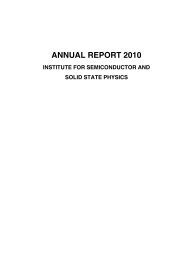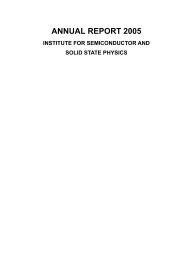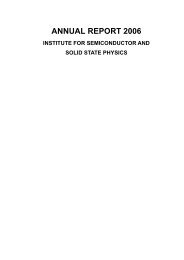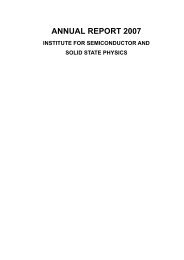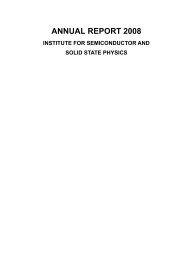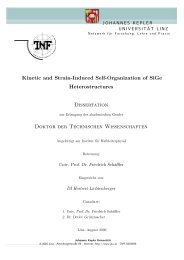Diplomarbeit Diplom-Ingenieur - Institut für Halbleiter
Diplomarbeit Diplom-Ingenieur - Institut für Halbleiter
Diplomarbeit Diplom-Ingenieur - Institut für Halbleiter
Create successful ePaper yourself
Turn your PDF publications into a flip-book with our unique Google optimized e-Paper software.
24<br />
Figure 3.6: (a) BF image of a PbTe/CdTe specimen, recorded slightly away of the [001]<br />
direction. The images show the mass-thickness contrast. The PbTe dots appear darker<br />
than the surrounding CdTe host material (mass contrast). A thickness contrast can be<br />
seen at the top and the bottom of image (a). The diffraction contrast is dominating in the<br />
DF image (b). The (020) spot, which is a forbidden reflex for the zb lattice, was used for<br />
image formation. Thus, the PbTe dots appear bright in a dark background. In addition,<br />
the dots in the thicker areas, which are not visible in image (a) are visible in image (b).<br />
(c) shows a diffraction pattern, that was recorded slightly away from the zone axis, so<br />
that the (020) reflex is the brightest of the {200} spots.<br />
Figure 3.7: Sketch of the diffraction condition for CDF. (A) Common two beam<br />
condition. The spot +g(hkl) and 000 are excited. If now the +g(hkl) spot is moved to the<br />
position of the 000 spot it becomes weak and the +g(hkl) spot is strong (B). If the<br />
opposite –g(hkl) spot is tilted toward the 000 position (C) the reverse two-beam<br />
condition is now applied to this spot. [32]




